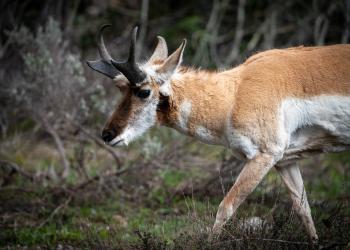Natural Resources
A critical part of the Forest Service mission is protecting and managing the national forests and grasslands so they best demonstrate the sustainable multiple-use management concept. The Forest Service is charged with managing natural resources in a way that best serves the multiple needs of a growing and changing nation. The agency was initially established to ensure a renewable supply of timber and a steady source of clean water and minerals.
Rangeland & Grazing

Well-managed rangelands provide forage for wildlife and domestic livestock in addition to quality water and recreational values.
Animals & Plants

The Bridger-Teton National Forest supports six species of amphibians, six species of reptiles, 74 species of mammals, 355 species of birds and 25 species of fish.
Wild & Scenic Rivers
Over 400 miles of rivers and streams in a single watershed, all designated at once as the Wild and Scenic Snake River Headwaters.
The public has been working alongside the Forest Service to determine how best to manage the 315 miles of those waterways on the Bridger-Teton National Forest (the rest are managed by National Park Service and US Fish and Wildlife Service).
The Bridger-Teton National Forest is in the process of completing a Comprehensive River Management Plan for the stream segments designated in 2009. (Map)
The foundation for preparing a comprehensive wild and scenic river management plan is to clearly articulate designated rivers’ outstandingly remarkable values (ORVs), water quality, and free-flowing character, so that these values can be protected and enhanced in accordance with the mandate of the Wild and Scenic Rivers Act. Staff from the U. S. Forest Service, in collaboration with the National Park Service, U.S. Fish and Wildlife Service, and Wyoming Game and Fish Department, with public input, developed the following set of draft ORV statements for the Snake River Headwaters. Because free-flowing condition and water quality support the integrity of the rivers’ outstandingly remarkable values and are key components of the planning effort, they are addressed at the end of the ORV statements.
Below is a list of the designated waterways on the Bridger-Teton National Forest:
- Bailey Creek
- Blackrock Creek
- Buffalo Fork
- Crystal Creek
- Granite Creek
- Gros Ventre River
- Hoback River
- North Buffalo Fork
- Pacific Creek
- Shoal Creek
- Snake River
- Soda Fork
- South Buffalo Fork
- Willow Creek
- Wolf Creek
The National Wild & Scenic Rivers System and the Snake River Headwaters FAQs
The WSRA establishes a national policy and program to preserve and protect selected rivers, or segments of rivers, in their free-flowing condition.
The Wild and Scenic Snake River Headwaters was added to the National System by Public Law 111-11 (P.L. 111-11—March 30, 2009).
To be designated under the Wild and Scenic Rivers Act, rivers or segments of river must be free-flowing and possess at least one “outstandingly remarkable” value—such as scenic, recreational, geologic, fish, wildlife, historic, cultural, or other similar features. Congress or the Secretary of the Interior may add rivers to the National System.
The Snake River Headwaters' exceptional scenery, fisheries, wildlife/ecological, recreational, geologic, and cultural resources are the outstandingly remarkable values for which the river system was designated, along with its free-flowing condition and high water quality.
WSRs are managed to protect and enhance their free-flowing condition, water quality and outstandingly remarkable values (ORVs). This nondegradation and enhancement policy allows existing uses to continue on federal lands where they do not conflict with river protection. Through development of a management plan and in ongoing management, the river-administering agency works with its partners to identify and resolve any activities adversely affecting river values on federal and nonfederal lands.
The U.S. Department of Agriculture (USDA), Forest Service, has the responsibility to manage a large portion of the Snake River Headwaters, including regulation of surface waters for recreational activities. Although the Forest Service manages the river system and has management authority on National Forest System lands, stewardship is a shared responsibility because the Snake River Headwaters flow through both public and private lands. Many different people—from private landowners to members of federal, State, county, and private organizations— will interact with one another in decision-making, working together to protect these special places.
WSR designation helps to protect and enhance a river’s current natural condition and provide for public use consistent with retaining those values. Designation affords certain legal protection from adverse development; for example, no new dams can be constructed and no federally assisted water resource developments can be allowed if they would adversely affect designated river values. Where private lands are involved, the river-administering agency works with local governments and landowners to develop protective measures.
Rivers added to the National System by Congress are classified in one of three classes depending on the extent of development and accessibility along each segment:
Recreation Those rivers or sections of rivers that are readily accessible by road or railroad, that may have some development along their shorelines, and that may have undergone some impoundment or diversion in the past.
Scenic Those rivers or sections of rivers that are free of impoundments, with shorelines or watersheds still largely primitive and shorelines largely undeveloped, but accessible in places by roads.
Wild Those rivers or sections of rivers that are free of impoundments and generally inaccessible except by trail, with watersheds or shorelines essentially primitive and waters unpolluted. These represent vestiges of primitive America.
A river’s classification does not represent the values for which it was added to the National System. For example, a “recreational” river does not necessarily mean recreation is an ORV or that this segment of the river will be managed for recreational activities. The direction in the WSRA to protect and enhance the river’s values (free-flow, water quality and ORVs) applies equally to each of the three classifications.



